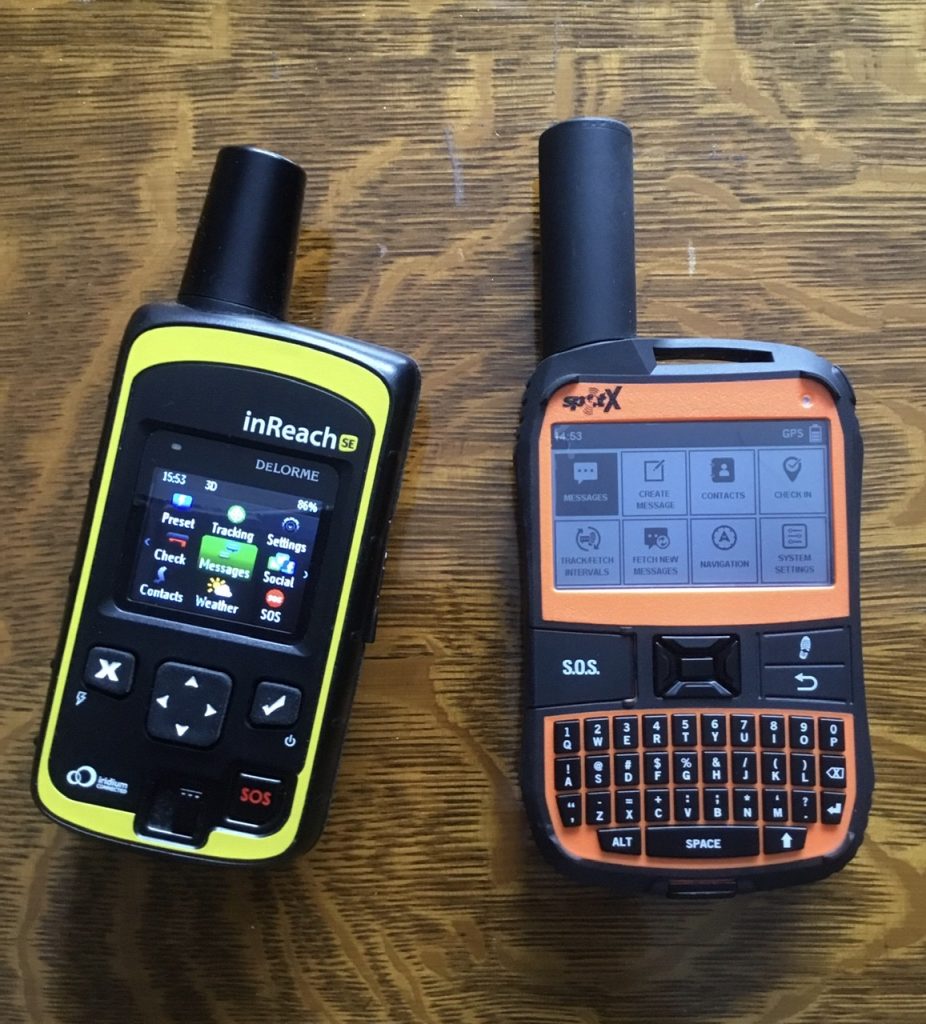
I fly in very remote areas. I also live off grid in the Yukon, far from cell service, landline and internet. The advent of personal satellite-based messaging devices was a godsend, allowing near-real-time text communications in areas that were previously incommunicado, or at best, where communications were unreliable to say the least. Remember HF SSB and the infuriating SBX11? How about VHF mobile phones?
As soon as they came on the market, I bought both the inReach SE (original Delorme, not Garmin) and, a few years later, the Spot X. I recently upgraded the Spot X to the Bluetooth model. This is a real world comparison of these devices. (I don’t have any experience with the newer Garmin inReach SE+, but in conversations with owners, it seems that most of my comments re the older device are still valid for the newer one.)
To be fair, there are other options out there, such as satellite phones and satellite internet, but these are expensive to buy and run. The Spot X and inReach devices are inexpensive enough to be accessible to most anyone needing communications from just about anywhere.
First, the nuts and bolts: both devices send and receive texts well and with similar reliability. (This is not a review of the tracking/mapping functions that these devices have. I generally don’t use them. Also, there are plenty of reviews of these functions out there already. Suffice it to say that the SpotX tracking function is not very good. If you need accurate tracking, Spot Gen 3 or 4, or inReach will perform just fine.) In a recent session of about 1000 inReach messages going back and forth from my place in the Yukon, there were no dropped messages. Spot is not quite as good, but is perfectly acceptable. This is an improvement from previous performance. There have been recent upgrades to both satellite systems (Globalstar (Spot) and Iridium (inReach)) which likely account for the high reliability. Also, Spot and Garmin are in direct competition and they each want to come out on top, so frequent upgrades and improvements can be expected.
Notwithstanding the above, message delivery times normally range from a few seconds to a few minutes (rarely, hours), and are closely related to device orientation and sky view. Satellites come and go on a time scale of minutes, so the device may have to wait for a few minutes or more to connect to the network.
Both devices have tracking and SOS functions. See my comments above and below re tracking. Also, I have no direct experience with the SOS functions of either device (knock on wood 🪵).
Both devices also do email, with a caveat: character limits apply, so if you send an email from the device, the recipient must delete all content from any reply, including the original message and the subject line, before composing a reply, or the character limit will be exceeded and the message will not send.
Now the picky things, in no particular order:
Spot X is about half the cost to purchase and operate as inReach.
InReach is global. Spot X is not. Check their service area map before you buy. North of 52 degrees north latitude, Globalstar satellites are always to the south (their orbital inclination is 52 degrees) so Spot X will need a good view in that direction. The further north you are, the lower in the sky the satellites will be. At my place in the Yukon, Globalstar satellites never get more than about 55 degrees above the southern horizon. Not so for Iridium satellites; they are in polar orbits and can pass overhead at any point on the globe.
Spot X prefers to be upright and have a good sky view. This is especially true for the tracking function to work at all. InReach is a bit less fussy about device orientation.
Customer service for Spot is excellent. Since I am a Canadian customer with an existing account, my inReach account is administered through a Canadian reseller called Roadpost. Their customer service is also excellent. I can’t speak about Garmin’s customer service. If you are not Canadian, or are setting up a new account, you will be dealing with them.
The Spot X interface is clunky and buggy. Some examples: odd things sometimes appear on the screen, the back button occasionally takes me through loops of screens that never go anywhere, and keys occasionally take a second or two to respond. When the Bluetooth model is paired with a smart device, the experience is much smoother (see below). Make sure you have the latest firmware. These comments apply to version 2.5.0.
The inReach interface is much more highly evolved and smooth. When paired with a smart device, everything is seamless. InReach is paired to a smartphone using the Earthmate app, which is very good.
Incoming Spot X messages occasionally appear in the preview screen only, and are not inserted into their respective threads. Since the preview is overwritten as soon as a new message comes in, this can cause messages to be missed entirely. One temporary fix is to delete the offending thread. A reset also works for a while. Hopefully a future firmware update will fix this. (So far, the Bluetooth model hasn’t had this issue. The October 2020 or September 2021 firmware updates may have solved this and other issues.)
InReach will generally not collect new messages on its own, even though multiple listen intervals come and go. You will have to perform a manual check or send a new message to force it to collect new incoming messages. This might be related to Iridium. I’ve been told that Zoleo (which is also Iridium) has the same issue.
Spot X sometimes locks up, requiring a reset, and sometimes turns itself on while just sitting in my flight bag.
InReach sometimes turns itself off. This is not related to battery level.
Battery life is similar for both devices.
InReach can send texts up to 160 characters. Spot X character limit is 140.
If an incoming message is too long, it screws up the system and causes the too-long message and any subsequent messages to be chopped up into little chunks of a word or two, which are then sent out of order and frequently dropped altogether. This happens with both devices. Each tiny message fragment counts as one of your allotment so unless you have an unlimited plan, this can get expensive. It would be nice if the system would not accept too-long messages in the first place. (My spies tell me an intermediary message-handling company called Nexmo is where this trouble originates.) (March 2022: this issue may have been resolved.)
With Spot X it is easy to compose messages on the device. With inReach it is not. You will want to pair it with your phone, although on-device messaging is possible if quite slow.
The onboard backlit keyboard on the Spot X is very nice.
InReach can get weather forecasts (they can be delightfully inaccurate in remote areas). With Spot X, you will have to text someone and get them to look one up for you.
As I’ve mentioned before, for the tracking feature to work at all with Spot X, the device must be upright. It won’t sit that way naturally, so some kind of cradle or stand will need to be fashioned (the Bluetooth version comes with a stand). Laying down, fewer than half of the tracking points actually get through. InReach is better in this regard. If you want bulletproof tracking, get a Spot Gen 3 or 4.
InReach can be set to “ring until answered” when there is an incoming message. Spot X can repeat its new-message notification chime at 5 minute intervals. If paired with a smartphone, neither device will cause an audible notification on the phone.
Incoming messages on the Spot X may or may not cause the new message icon to appear, leading to missed messages.
The Spot app sometimes has difficulty figuring out if it is connected to the device. It will repeatedly display an error that it is not, even though it is. This has improved after the September 2021 firmware update.
Even more problematic, when using the predefined message feature, the Spot app will sometimes send a different predefined message than the one selected. When sending “taking off” to dispatch, the app thoughtfully sent “good night, I love you” instead. Yikes…
An outgoing Spot X message may remain in the outgoing message queue and not be marked as delivered long after it has actually been delivered. This is frustrating as the outgoing message queue will only hold so many messages (4 in my experience), and a message doesn’t get dropped from the queue until it has been marked as delivered. This can prevent you from placing any new messages in the queue. You have to manually cancel the offending message in this case. (This happens even with excellent sky view.)
Spot X has a dedicated phone number which never changes. The inReach number refreshes periodically, meaning people may not be able to initiate a conversation after a delay of several months.
Anyone who has the phone number can initiate a conversation with a Spot X. With inReach, the inReach device must initiate the conversation.
With inReach, it’s easy to switch plans and put the device into or out of suspension as your needs change. With Spot, it’ll cost you. There’s an extra fee to have an account that allows suspending. As for switching plans, it’ll cost you to downgrade.
So which one do I use more? InReach. The main things that swung me in that direction are:
When paired with a smartphone, the experience is user-friendly and intuitive.
Easy to switch plans or suspend the plan. Leads to lower overall cost.
I may change my mind when Spot becomes a little more bug-free.
My wish list for Spot X firmware developers:
Squish some bugs, both in the device firmware and the Spot X app.
Improve the “new message” alert and icon reliability.
Improve the “message delivered” notification speed and reliability.
160 characters would be nice (this may be a Globalstar vs Iridium issue and beyond Spot’s control).
What not to expect from these devices:
Instant texting just like your phone. It won’t happen. They are simply not that fast.
Works from anywhere. They don’t. Poor sky view severely limits performance. In a vehicle or aircraft, the device must be in the windshield and oriented correctly to work properly. In a building, expect reduced or even non-existent functionality.
Strictly for messaging, either one of these devices would be a good choice. They are not the same, but considering their main functions, sending and receiving messages and distress signalling, they each do their jobs well. If reliable tracking is your priority, choose inReach or Spot Gen 3 or 4.
March 2022.
